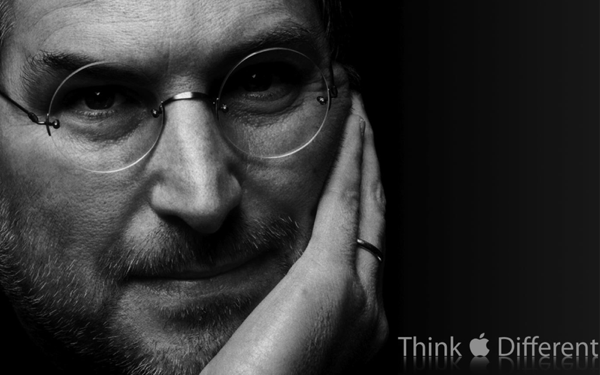4 Things Microsoft Could Learn From Steve Jobs

What words come to mind when asked to describe Microsoft today? Cool, stylish, revolutionary, and innovative are probably out of the question. However, those words could easily be used to describe Apple. So maybe the brains at Microsoft could learn a thing or two from one of the few brilliant CEOs of our times, who just so happens to be the leader behind Apple’s success — Steve Jobs.
Problem #1: Designers, Designers, Designers!

Let’s be real: Microsoft’s products aren’t particularly well-known for their design — they simply aren’t on par with their competition’s offerings. Sure, there was a time when layering in every possible option, button, gizmo, menu bar, and whatnot was all the rage, but those times are long gone. People are looking for something different. That difference is in the design.
People are now willing to pay a huge premium for a well-designed product, and Apple’s fan base (and sales numbers) is living proof of that. But Microsoft hasn’t caught on to this trend. The company has fallen so far behind the times that it has to make one question if Microsoft has had any feasible concept of what design is for most of the past decade.
Furthermore, Microsoft’s focus on developers (developers, developers!) has always been a priority for the company, but computers and software programs are no longer unbelievably complex or used by only the geekiest among us all. It’s now expected that younger (and, in many cases, older) people are computer literate. These people want product designs that are suited towards meeting their needs and getting the job done.
Lesson From Steve
Steve Jobs realized that there is a certain group of people who prefer practicality and beauty over functionality. It might come off as a bit dictatorial, but today’s consumers are increasingly willing to forgo the comfort of control, openness, and customization for an overall improved experience. Apple’s designers have changed the expectations and quality in product design, and Microsoft would be wise to explore these trends — especially if they intend on remaining competitive in the eyes of consumers for the long term.
Problem #2: Lack of Focus

Microsoft has a tendency to create many experiments, products, and concepts, but how many of those turn into successful and profitable endeavors? Very few, just like the Kin, the Courier, and the Zune.
Sure, these projects and experiments are interesting — and it is fun to envision the future of technology — but these pet projects are doing little, if anything, for consumers today. More importantly, it’s a drain on the company’s resources and bottom line. If it isn’t generating consumer interest or revenue, what is the point?
Admittedly, Microsoft has plenty of cash to burn, but this money should be considered as a finite resource, especially for a company that is being dominated by its competition in the consumer marketplace. It also doesn’t help that Microsoft’s revenues have suffered lately from the declining economy.
Lesson From Steve
Steve Jobs doesn’t mess around with crazy experiments and unprofitable endeavors. He ensures that his company’s resources are directed towards improving profitable products and creating new products that result in interest from consumers and, most importantly, generate revenues. As iTunes, Mac OS X, Apple TV, iPod Touch, App Store, and iPhone have revolutionized their respective industries, Microsoft has little to brag beyond its impressive operating system share. So it’s time for Microsoft to knuckle down.
Problem #3: Product Disparity

Another serious issue for Microsoft is that a majority of their products have little connection to each other. This is particularly true with their Internet-based products. Xbox Live, Zune Marketplace, Hotmail, Bing, MSN, and Skydrive are all great products in their own right, but it requires too much of an effort for a user to take advantage of these services with ease.
If you look at larger companies like Apple or Google or smaller companies like Zoho and Facebook, their products have something in common: they tend to work well together, if not seamlessly. They offer a universal experience that helps keep the user interested in all of the company’s various products and services. But Microsoft hasn’t managed to accomplish this, and until the they do, I fear that consumers will continue to leave Microsoft’s products for alternatives that are offered in a more convenient and unified offering.
Lesson From Steve
Jobs has created a single developer and content platform that holds the core of the Apple’s entire future — it is iTunes. He has been executing a strategy to integrate all of Apple’s products into a single platform that is rich with content. It is, in a word, genius (now we know why Mac OS X hasn’t received much love lately and might eventually be phased out). Digital content distribution is the future, and iTunes is in the best position to handle that task. Microsoft doesn’t need to take it as far as Steve Jobs has taken it with iTunes, but there is certainly an impressive lesson here that could be exploited in the future: a single, unified marketplace that combines desktop, mobile, and Web-based products could be huge hit.
Problem #4: Company Image

Finally, brand loyalty is a big part of consumer behavior nowadays. Every company has their loyalists (i.e. fanboys and fangirls), and these people are an integral part of spreading the word about products and services. However, if you asked any tech-savvy teenager or twenty-something to give an example of an impressive technology company, you would be hard pressed to see Microsoft’s name mentioned.
It’s all a perception, and few companies have managed to create an amazing perception of themselves. Apple is cool. Google is cool. Sony is cool. Others, however, haven’t managed to handle their public image: Microsoft is not cool.
Think about it: who actually walks into a store with the sole intention of buying a Microsoft product?
Lesson From Steve
If Steve Jobs has done anything right above all else, creating an impressive image for Apple and himself is it. But Jobs didn’t accomplish this with any one single action: he put in years of effort and consistency to create a company that most can only dream about. Decade-long efforts have constantly produced household-name products year after year, and this is probably the most important lesson that Microsoft could learn from Jobs.





3 things Steve Jobs could learn from Microsoft:
– Give me a “Show Desktop” button. I want it. I don’t know of anyone who specifically doesn’t want it. When I click it Maybe if Apple did any type of user testing whatsoever, they would know this.
– Play nice with the other big companies. MS ain’t the greatest company in the world at this, but I’m sure if they made a DVD authoring program aimed at media professionals it would support bluray, and if they made a mobile OS (which they do), it would be able to run flash apps (which it does).
– When others have good ideas, rip them off. Why does windows 7 look good? They took the good shit from OS X and mooshed it with what they learned from designing XBOX 360. If someone else has a good idea and consumers like it, steal it and tweak it. Gates isn’t so narcissistic to think he is the only company on the planet that can come up with good ideas.
All this will play into a significant decrease in Apple’s market share in the next 5 years. 90% of people still use Windows, and there’s much more than just OS X in the other 10%. I really think Apple lacks the ingenuity and commitment to quality it takes to stay competitive. Did you see the latest iPhone? It features an unimpressively sized screen, reception issues, and limited bandwidth (nice choice of exclusive wireless partner Apple.) Their big innovations were a clearer screen (not noticeably better than the Evo, in my opinion) and video chat that you need to have WiFi access and a person on the other end who also bought an iPhone to use. That’s called Skype, and we’ve had it for years.
Their restrictive app store policy and low cost, high quality competition from companies like Google will soon push Apple back to the same shadows the were sitting in for most of the 90s.
To your first point………it’s called “Exposé”. Next time you’re on a Mac hit the F11 key and let the magic leprechauns do their work.
One more thing to add to your list is that Apple should bust down doors and take legal action for someone reviewing there products before they on on the market. They are getting a bad name for becoming the new big brother.
And test Hardware so they don’t have calls dropping and then try to say that all phones have problems with dropped calls.
I have had several different cell phones over the past 10 years and have had less than 5 dropped calls in my life.
Steve Jobs and Apple use to be cool about 10 years ago or so, but has lost its cool and sux…
1) OSX has “show desktop”. It’s called Expose. I have mine set to “expose desktop” with hot corners by a quick flick of the mouse to the lower right corner of the screen. Works beautifully, thank you. “expose windows” and “spaces” is very useful, natural to use and productive too.
2) Blu ray is a whole bag o’ hurt 😉 Sorry, couldn’t resist that one. I don’t much care for Blu-ray, so I don’t know much about it, so you might have some kind of point there but I do believe it won’t be long before all physical media will be superseded by “bits in the cloud”, anyway
3) Arrrggggghhh.
4) You better update your stats. OSX install base is currently around 11% of all operating systems, not just, to paraphrase: “part of the 10% that isn’t windows”. 10 years ago called, they want their statistics back.
5) iPhone 4 antennae issues? Yep they sure f**ked up there. Nothing else of what you stated, in my opinion has much validity. Just my opinion though, however I’m willing to be swayed by real facts.
Here’s someone who doesn’t need an extra button taking up precious screen real-estate. Here’s how I setup “show desktop”. Go to – System Preferences -> Expose & Spaces -> Expose and Select ‘Desktop’ in one of the active screen corners drop down menus. Done. Now if you move you mouse/trackpad to that corner, all you windows move out of the way to expose your desktop.
Alternatively, If you use a macbook/pro with a multi-touch trackpad, then try swiping ‘four fingers’ upwards. You many have to activate the gesture in System preferences for this to work.
As for the ‘Show Desktop’, there’s such function in Expose in MacOS X. Assign it to any functional key on the keyboard and/or a hot corner, and you’re good to go.
No “Show Desktop”-button will result in a “significant decrease in Apple’s market share”?
Wow, better get one.
This article has many good ideas in it, but I think the communication of MS is better than Apple’s (You are holding it wrong), this anti-flash thing. By the way, I am more satisfied with MS services than Apple’s.
Never mind, it was interesting, thanks for sharing!
Apple is cool, Microsoft is not. My guess is that its the black turtlenecks, jeans and sneakers.
another squabble from a mac lover
you can’t give full credit to a whole company to one man… nor can you even compare the two being incredibly one sided
get real macs are over priced and only still alive because of the ipod
Marc, you need to go learn a few things before trying to post anything about Apple, especially the Macs. They’ve been gettin it done in the arts and entertainment world since before you were probably even born. Go check out any recording studio or movie production company and see what brand of equipment they’re using.
Super article James and one I’ve been dying to write myself since I got my mac.
Up until 2 years ago I loved my PC in spite of the sh*& it gave me. I refused to move mostly because of the cost involved in transferring my software and hardware. I decided to make the leap when I figured out I was spending way too much time maintaining my PC at the expense of my design-time . The move has paid for itself.
The biggest differences for me is the stability of the OS and the UX.
Somehow Jobs has found a way of making the computer more personable and dependable. What??? A device made for people…with human interaction in mind…no way!
Now I live by this – “Once you go Mac, you don’t go bac!”